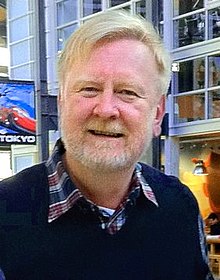William Reeves (animator)
| William Reeves | |
|---|---|

Reeves in December 2011 at the Pixar campus
|
|
| Born |
May 5, 1959 Toronto, Ontario, Canada |
| Occupation | Supervising Technical Director, Modeling, Animation System Development, Renderman Software Development |
| Employer | Pixar Animation Studios |
| Spouse(s) | Ricki Blau |
| Children | Julia, Oliver, & Ian Reeves |
| Awards |
1987 - Nominated: Animated Short Film For the development of the Marionette Three-Dimensional Computer Animation System. |
1987 - Nominated: Animated Short Film
Luxo, Jr.
1988 - Won: Animated Short Film
Tin Toy
1997 - Won: Scientific and Engineering Award
For the original concept and the development of particle systems used to create computer generated visual effects in motion pictures.
William "Bill" Reeves (May 5, 1959) is a Canadian animator and technical director known for working with John Lasseter on the animated shorts Luxo Jr. and The Adventures of André and Wally B.
After obtaining a Bachelor of Mathematics from the University of Waterloo and completing a Ph.D. at the University of Toronto, Reeves was hired by George Lucas as a member of Lucasfilm's Computer Division, Computer Graphics Group. He was one of the founding employees of Pixar when it was sold in 1986 to Steve Jobs. Reeves is the inventor of the first Motion Blur algorithm and methods to simulate particle motion in CGI.
Lasseter and Reeves received the Academy Award for Best Animated Short Film (Oscar) in 1988 for their work on the film Tin Toy. Their collaboration continued with Reeves acting as the Supervising Technical Director of the first feature length, computer-animated film: Toy Story.
In 1996 he became the 2nd awardee of the J.W. Graham Medal, named in honor of Wes Graham an early influential Professor of Computer Science at the University of Waterloo, and annually awarded to an influential alumnus of the University's Faculty of Mathematics.
...
Wikipedia
